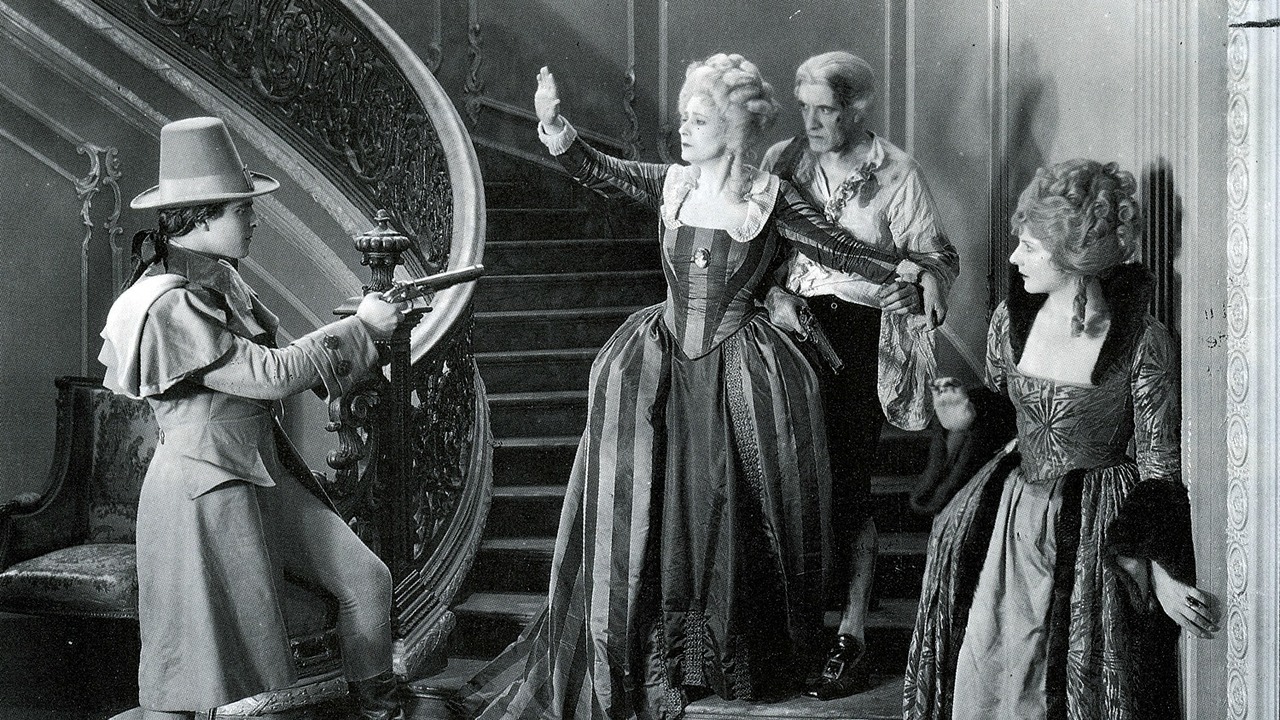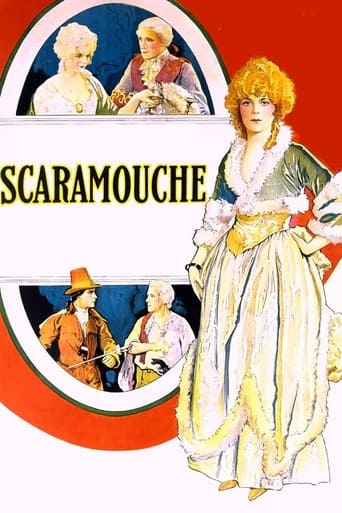

Those who are familiar with the well-known 1952 remake of "Scaramouche" might find it difficult to recognize it in this 1923 silent version. The story in this earlier and seldom-seen version is quite different in many respects. Many of the plot points are different, the names of some of the principal characters are not the same and some of the principal characters in this earlier version do not even appear in the remake. The earlier version is also quite different in tone, being rather more in the nature of Historical-Melodrama or Historical-Fiction than the later version, which is much more of a mere swashbuckler. However, the fact is that this earlier version is actually much more faithful to the original book than the remake.Don't be put off by the fact that this is a silent film produced 90 years ago, because it's production values are excellent. Clearly no available expense was spared to make this production as lavish and authentic to the period (France during the French Revolution), as possible. The director, Rex Ingram, was about as good as one could find at the time. The cast also features some first rate performers, including perennial MGM favorite Lewis Stone, who was probably with the studio longer than any other actor, so long that he appeared in the 1952 remake. The title role is played by Ramon Navarro, who was a major star in the 1920s. Like Rudolph Valentino, Navarro was a major leading man in the films of the 1920s, and had the title role in the silent version of "Ben Hur". However, unlike Valentino, who died young, Navarro continued to work for many years, though his career as a leading man waned after talkies came in. Navarro's problem in talkies was that he happened to be Mexican, and spoke with an accent.All in all, "Scaramouche" comes off as a lavish and well produced melodrama set against the background of the French Revolution. The plot points and tone are so different that it should be rated alongside, rather than above or below, the better-known swashbuckling remake. This film is very well worth a look, especially to the many fans of the 1952 version.
... View MoreYou'd have a difficult time recognizing this as the same story that the 1952 version was built around. I read the novel when I was a kid but can't say how closely either version sticks to the book. All I remember of the novel is that Rafael Sabatini didn't know anything about fencing.In 1952, Stewart Granger was Andre Moreau. His best friend, a social activist in pre-revolutionary France, is killed by an aristocrat who is a deadly swordsman, Mel Ferrer. The remainder of the movie has Granger on the run from the authorities, disguising himself as a comic figure in a traveling troupe, having an affair with one of the players, falling for a rich and delicate young lady, putting Herculean efforts into learning how to fence, and finally beating Mel Ferrer in a duel but allowing him to live.I don't mean to carry on at too much length about the 1952 version but it's probably more familiar to viewers than the 1923 silent, with Ramon Navarro as the hero, Andre. After a few similarities in the first half hour, the plots pretty much diverge.This version is at least equally expensive and it's well done for the time, but the emphasis is placed far more on politics than comedy or swordsmanship.Here, Andre spends hardly any time playing Scaramouche on stage. We see him in costume for about two minutes, and he does nothing that convinces us he's a comic genius. In 1952, Granger knows nothing of the sword at first and has three encounters with Ferrer, the last one rolling, or rather tumbling along in a theater for about fifteen minutes. What a duel! As well done any any other I've seen on the screen, about as good as that in "The Mark of Zorro", but more lavishly staged and more extended. In 1923, Navarro also doesn't know anything about fencing but we see him taking a lesson for about one minute, after which he is an unbeatable master of the weapon.The 1923 climax has nothing to do with a duel between the hero and the chief heavy. It has to do with the French revolution, into which Navarro has been swept up. The French nobility were bad enough, you know. "Let them eat cake!" All the noblesse and none of the oblige.But, caramba, the mob that took over was crazed and drunk and given to beheading everybody they could get their hands on. Not only did King Louis XVI get the guillotine but so did Robespierre, one of the fomenters of the revolution. Not that you see any executions in the film, just the outraged savages doing what outraged savages always do in these movies -- smash furniture.Anyway, the climax is shifted from a duel mano a mano to the epic story of the revolution and its immediate aftermath.This isn't a bad film, but I prefer the remake -- one of the rare times when the second version is as good, or better, than the original. It just happens to be one of those stories that benefit from OverwhelmoColor and sound. In 1952, the tinks of the metal swords meeting were created by the tinkling of crystal glass. The 1923 is good; the 1952 is phenomenal.
... View MoreThe 1923 "Scaramouche" has all the elements of an epic film saga -- intricate and plausible sets and costumes, clearly drawn characters, ever more intense pacing -- but it just failed to catch fire for me. Maybe it's the way it makes no pretense of being anything but a big bundle of melodramatic clichés wrapped in a too-transparent plot. Too bad; it sure had potential. If you can see the Turner Classic Movie version, with the new score by Jeff Silverman, do so. It's how film scores should be created for silent pictures like these, absolutely in sync with the action but not slavishly commenting on every little detail. Usually it's a backhanded compliment to say that one finds one is losing oneself in the movie and not paying any attention to the score, but in this case, believe me, it's the mark of a resounding success.
... View MoreHad I never read the original novel "Scaramouche" by Rafael Sabatini and had I never seen the amazing Stewart Granger film of the 1950s, then I probably would have loved this silent movie. However, the book was so good and the Granger film so perfect that I found myself forever comparing this silent epic to the others and it usually came up short. In a way, that's sad, because it IS a very good film--especially compared to other films of the day.The basic plot is set in the days just following the French Revolution of 1789. For a few short years, the country had still not slipped into radicalism and the country was ruled by a coalition of the old elite and young upstarts. Eventually, of course, most of the elite would be executed or run off to exile, but this film is set during the last gasps of the nobles--who STILL exercised some of their old clout.Andre (Ramon Novarro) is an orphan who hobnobs with the upper crust but is definitely not one of them. When his best friend is murdered by an evil nobleman (Lewis Stone), he vows revenge and soon becomes a very outspoken critic of the rich. However, because of his outspokenness, he is marked for death and so he hides with a traveling theater company. He becomes very successful for the plays he writes as well as his rendition of the classic "Scaramouche" character. During this time, he also practices with the sword in the hopes of one day killing Stone. Eventually, his fame on stage increases so much that he is invited to serve in the Parlement. Plus, they want him because his swordsmanship is so good they figure he'll be able to protect himself--as the nobles are always dueling with their opponents killing them (a great way to deplete the non-elite class in Parlement).All this leads to the expected ultimate showdown with Stone, though it ends differently than the Granger film and more like the original novel. In some ways, this isn't bad, but what is missing is the great sword fight between Novarro and Stone--it ends almost as soon as it begins! In the Granger version, the fight is the longest and best sword fight in film history and something you can't miss.Apart from the fight that just fizzled, the film does have excellent sets, cinematography and musical score (something many silents do NOT have when shown today). It's good,...but I just can't help but prefer the sumptuous and more entertaining remake. This is one of the few cases when I do prefer a remake--so it just goes to show you how wonderful Stewart Granger's version is. If you only want to see one version of the film, see that one.
... View More